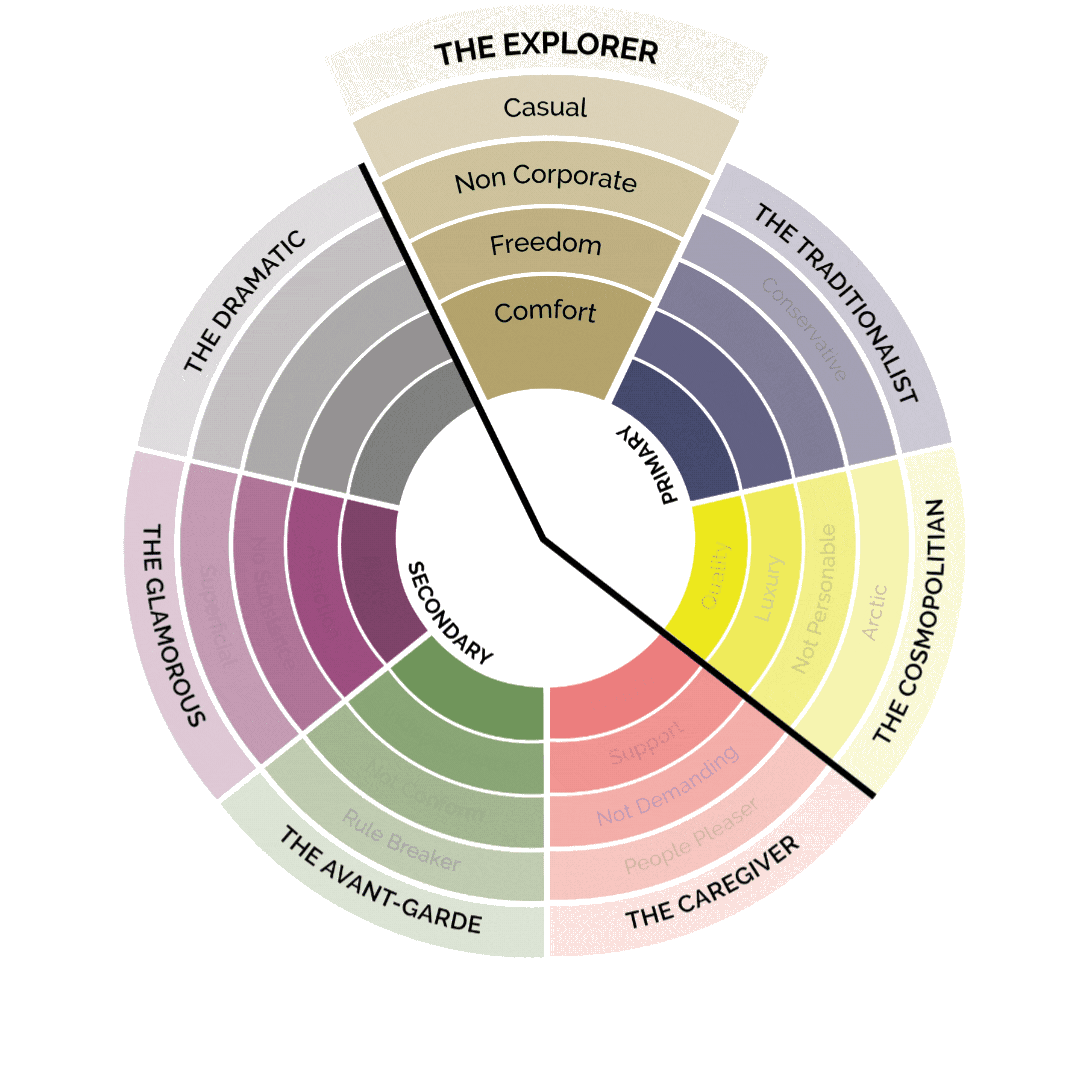THE NEXT 21 Most Common Mistakes in Sales
Part 2: Why You Fail to Make an Impactful First and Lasting Impression in Sales
At the heart of successful sales is the ability to make a positive and lasting impact on your clients. Whether you are meeting with clients for the first time or closing a deal, you must have all the necessary materials and information to successfully navigate each interaction. With strong organizational skills and an understanding of industry trends and data, you can build strong relationships with your clients and ensure they have a positive experience working with you.
You’re Not Using Positive and Upbeat Language
Your communication must be positive and upbeat when communicating with clients. If it’s not, you may send a message of negativity, whether intentional or not. Choose your words carefully, so you don’t seem like a downer. If you are not using positive language, clients may lose interest in your product and stop listening to your sales pitch. To succeed in sales, you must always use positive language.
Signs that you are using positive and upbeat language:
- You actively focus on the benefits of your product or service, highlighting how it can make a client’s life easier or more productive.
- You regularly use positive and encouraging language, such as “you can do it” or “that’s a great idea.”
- You speak in an upbeat and confident tone, conveying your belief that the product is suitable for the client.
- You include words that reflect the future and show your belief in the client’s potential, such as “you will succeed” or “you can achieve anything.”
- You focus on how your product or service can help clients achieve their goals rather than dwelling on any possible shortcomings.
You’re Not Exhibiting a Positive Attitude
Positivity comes across in the things you say and do. Pay attention to the message you send through your words and actions to ensure you always exhibit a positive attitude. If you are not exuding positivity, clients may lose interest in your product and choose to work with someone else. To be successful in sales, you must always have a positive attitude and convey that through your words and actions.
Signs that you are exhibiting a positive attitude:
- You approach sales interactions with enthusiasm and optimism, conveying a genuine interest in helping clients achieve their goals.
- You are always willing to go the extra mile when working with clients, offering your help and support whenever necessary.
- You take feedback from clients in stride, viewing it as an opportunity to improve your product or service.
- You make a conscious effort to keep your emotions in check, maintaining a positive and professional demeanor at all times.
- You take pride in your products or services, viewing them as high-quality and valuable offerings that clients will appreciate.
You’re Not Staying Calm and Collected Under Pressure
The business world is unpredictable. You never know what may happen in the middle of a meeting. You may get rudely interrupted, or a client’s actions may throw you off balance during the meeting. In any case, it’s essential to stay calm and collected. Do deep breathing or whatever it takes to keep your cool and put your best foot forward. If you are not staying calm under pressure, clients may lose interest in your product and become disengaged from the sales conversation.
Signs that you are staying calm and collected under pressure:
- You consciously anticipate difficult situations or challenging conversations with clients, preparing for them ahead of time.
- You practice active listening and remain open to client feedback, even if it’s not what you want to hear.
- You approach sales interactions confidently in your product or service and believe you can successfully help the client achieve their goals.
- You take a step back when faced with challenging situations, allowing yourself time to collect your thoughts and respond rationally.
- You maintain a positive mindset, viewing complicated sales interactions as opportunities to grow and improve your approach.
You’re Not Presenting Yourself Professionally in Your Demeanor or Appearance
Some of us would like to show up for work in our pajamas. But be aware of the message your demeanor or appearance sends to clients. It’s important to dress appropriately no matter what. Likewise, you should maintain a professional demeanor in all interactions with clients. If you are not presenting yourself professionally, clients may lose interest in your product and choose to work with someone else.
Signs that you are presenting yourself professionally:
- You are mindful of the message your words and actions send to clients, always maintaining a positive and professional demeanor.
- You pay attention to your appearance, dressing appropriately for every sales interaction.
- You take the time to build rapport and establish trust with clients, recognizing that this is key to building solid relationships.
- You put your best foot forward in sales interactions, actively seeking opportunities to improve yourself and your product or service.
- You are respectful of others’ viewpoints, even if they differ from yours, and make a conscious effort to maintain a positive attitude at all times.
You Don’t Have a Memorable Elevator Pitch
You must engage your client from the get-go when it comes to sales pitches. Open with something boring, and you can lose them forever. But if you have a robust and memorable elevator pitch, you can capture their attention and convince them to choose your product or service.
Signs that your elevator pitch is memorable
- You can distill your product’s or service’s main benefits into a one-sentence elevator pitch that is clear, concise, and easy to understand.
- You use this pitch in all sales interactions and tailor it based on the needs and interests of the client, making it engaging and relevant from start to finish.
- You practice your pitch and have a strong, confident delivery that commands the attention of your clients.
- You can easily transition from your elevator pitch to the client’s needs and concerns, asking the right questions at the right time and building a solid rapport in the process.
- You continually refine and improve your pitch, seeking feedback and new ideas to stay ahead of the competition.
You’re Not Using Strong and Persuasive Language
Overly salesy pitches can be a turnoff. But you must use strong and persuasive language in your pitch to yield a conversion. Perfect your pitch to include language that converts without appearing too strong.
Signs that you are using strong and persuasive language in your pitch:
- You use a combination of facts, figures, and client testimonials to support your product or service.
- You carefully craft your sales pitch to appeal to the specific needs and interests of the client, tailoring it for each interaction.
- You choose your words carefully and express yourself clearly, concisely, and confidently.
- You use persuasive language techniques such as framing, reciprocity, and scarcity to convince clients to act on their interest in your product or service.
- You engage with prospects by asking questions, listening intently to their responses, and adapting your pitch based on their feedback.
You’re Not Closing the Pitch with a Call to Action
A call to action clearly states the reason for your pitch. It tells your clients what you want them to do whether it be buying your product, signing up for your newsletter, checking out your website, etc. Without a CTA, clients may be uncertain of your message. It’s best to include the CTA at the end of the pitch to make it memorable.
Ways to close your pitch with a call to action:
- Create a sense of urgency by using language that conveys your product’s or service’s importance and benefits.
- End with a statement about what will happen if clients don’t act now, such as “act now to take advantage of our limited-time offer” or “this promotion ends soon, so sign up today.”
- Use statistics and facts to highlight the benefits of your product or service and show how it will benefit customers in their daily lives.
- Appeal to the emotional side of decision-making by emphasizing your product or service’s benefits in improving people’s health, happiness, confidence, etc.
- Ask clients directly to take action on their interest in your product or service and offer a simple next step they can take immediately.
You’re Not Following Up After the Sale
After a sale is closed, the sales professional should reach out to the customer to ensure they are happy with the product. If they don’t do so, it will show that they care more about their commission than customer satisfaction. If they follow up, it will show a high level of care, likely to produce customer loyalty.
Ways to follow up after the sale:
- Send a personalized email or call to each customer after the sale, thanking them for their business and asking if they have any questions or need additional support.
- Check in with customers regularly, perhaps once a week or at the end of a month, to see how they use your product or service and provide any additional support or resources they may need.
- Offer incentives such as discounts, free trials, or special deals to customers who refer your product or service to their friends and family members.
- Maintain an active presence on social media platforms such as Facebook and Twitter, where you can share customer success stories and build relationships with potential customers.
- Provide a personalized “welcome package” to new customers that may include information about your product or service, tips for getting the most out of it, and special offers or discounts.
You’re Not Staying in Touch with Your Clients
Beyond the initial follow-up, staying in touch with your clients is essential. You can reach out with business news or just call to say hi. This will ensure your company is the first to come to mind when they require your products or services.
Signs that you are interested in staying in touch with your clients
- Sending them regular updates on new products or services, industry news, and special promotions.
- Connecting with them on social media platforms such as Facebook, LinkedIn, and Twitter to build relationships and stay top of mind.
- Hosting events such as webinars and seminars that allow customers to learn more about your products or services and interact with your team members.
- Offering them exclusive discounts, special deals, or free trials on your products or services.
- Asking for feedback and taking the time to respond to any questions or concerns they may have.
You’re Not Going Above and Beyond for Your Clients
Clients want to see that you are making that extra effort to maintain their loyalty. Following up and staying in touch will show you are going that extra mile. You can also provide additional services on top of what they requested to keep them happy. This will help you stand out from competitors and increase customer retention.
Signs you are going above and beyond for your clients:
- Offering additional support and resources, such as online training or customer success days.
- Incorporating their feedback and suggestions into future product updates and new product development.
- Providing custom solutions to address their specific needs, whether a customized product or an on-site consultation by one of your team members.
- Maintaining a high level of transparency and communication, keeping them updated on their order status or any issues that may arise.
- Providing personalized or customized service, such as custom packaging or special offers for your most loyal customers.
You’re Not Responding to Client Inquiries and Requests in a Timely Manner
Clients want answers, and they want them now. Not responding promptly shows you are not prioritizing their needs. They may become frustrated and go with another company that offers better response times.
Signs that you are responding to client inquiries and requests promptly:
- Answering phone calls or emails within 24 hours or immediately if it is an emergency.
- Providing regular updates on the status of their project or order, including any issues that may arise and how you are addressing them.
- Offering alternative means of communication, such as live chat, to ensure that their needs are always met.
- Collaborating with other team members or departments to develop the best solutions for your clients.
- Maintaining an open dialogue, proactively reaching out to offer support, and responding to any questions or concerns they may have.
You’re Not Keeping Up with Industry Trends
Companies should constantly stay on top of industry trends to ensure they can provide their clients with the best products and services. It’s the only way to keep up with the competition. If you are not familiar with the latest trends, you may lose out on sales or fall behind in quality and innovation.
Signs that you are keeping up with industry trends:
- Signing up for newsletters, webinars, or online courses to stay informed about new developments in your field.
- Conducting regular research on competitor products and services, as well as customer reviews and feedback, to stay ahead of any new trends or changes in the marketplace.
- Attending trade shows and conferences to network with other professionals in your industry and stay up-to-date on the latest developments.
- Consulting with experts or thought leaders in your field, either through individual consultations or industry advisory boards, to gain expert insights into emerging trends and best practices.
- Collaborating with other companies or organizations in your industry to share knowledge and resources, such as through joint product development or innovation initiatives.
You’re Not Using the Latest Technology
The latest technology is essential in helping you provide the best products and services to clients. Keep up with current trends to ensure you are on the cutting edge. Not using the latest technology, such as AI-driven products or cloud computing, can put you at a disadvantage against your competitors.
Signs that you are using the latest technology:
- Utilizing CRM and sales platforms to help streamline your sales processes and better track client activity and engagement.
- Implementing predictive analytics to help identify trends and anticipate the needs of your clients.
- Using data visualization tools to better understand your sales performance and make data-driven decisions.
- Integrating AI into your products or services to improve efficiency, accuracy, and customer experience.
- Ensuring that your website is optimized for mobile use so that it is accessible on an array of devices and platforms.
You’re Not Taking Advantage of Social Media to Engage with Clients
Companies must take advantage of every platform to keep customers engaged. That includes social media. Sales professionals should be using social media to respond to customer inquiries and comments and posting regularly. Not using social media to engage your clients can decrease sales and customer satisfaction.
Signs that you are taking advantage of social media to engage with clients:
- Posting regular content on your company’s social media profiles, including product announcements, promotional offers, client testimonials, and more.
- Monitoring social media for user feedback and comments and responding promptly to any questions or concerns.
- Offering live chat support on your website lets customers quickly get in touch with a sales professional during busy periods or outside office hours.
- Enlisting the help of social media influencers or advocates to promote your products and services through word-of-mouth marketing.
- Encouraging your sales pofessionals and staff to be active on social media as brand ambassadors, sharing news about the company and industry updates with their online networks.
You’re Not Maintaining a Strong and Professional Online Presence
It’s crucial to maintain a strong presence across all online platforms. You should have a visible website and include yourself in directories, etc. In addition to maintaining a robust online presence, you must also maintain a professional presence. Refrain from posting anything potentially embarrassing.
Signs that you are maintaining a strong and professional online presence:
- Networking with other professionals in your industry on social media, including other sales professionals, business owners, and thought leaders.
- Creating a LinkedIn profile or company page that highlights your expertise and experience in the field.
- Refraining from posting anything overly personal or controversial online, as this can negatively impact your professional image.
- Staying up-to-date on current trends and best practices by regularly reading sales blogs or following influencers on social media.
- Monitoring online reviews and responding to feedback or complaints can help you identify areas for improvement in your sales process.
You’re Not Exhibiting Good Manners and Common Courtesy
Good manners and common courtesy should go without saying. If you are not saying please and thank you and failing to hold the door for those behind you, you may want to brush up.
Signs that you are exhibiting good manners and common courtesy:
- Showing a willingness to go the extra mile for your clients, whether responding promptly to their emails or offering personalized service that goes above and beyond what is expected.
- Smiling and maintaining positive body language in all interactions, even when dealing with demanding customers or challenging situations.
- Respecting your colleagues and customers, including using appropriate language and avoiding gossip or backbiting.
- Offering gifts or small tokens of appreciation on special occasions, such as birthdays or holidays, to show your gratitude for their business and loyalty.
- Demonstrating a strong work ethic by arriving early to meetings, consistently meeting deadlines, and taking on additional responsibilities without being asked.
You’re Not Reading Verbal Cues and Body Language Correctly
The message your clients are sending won’t only come through in their words. You must pay attention to their body language as well. It may be telling you something their words are not expressing.
Signs that you are not reading verbal cues and body language correctly:
- Obsessing over minor details or mistakes rather than focusing on the big-picture goals and overall performance.
- Interpreting a neutral tone or facial expression as disinterest or indifference when it may just be someone’s natural manner of communicating.
- Failing to ask questions or follow up when your client is distracted, fidgeting, or looking away.
- Interrupting others during meetings and presentations rather than listening carefully and asking for clarification when needed.
- Discounting the importance of non-verbal cues or body language in general, believing that words are the only thing that matters.
You’re Not Doing Your Homework Before Meeting with Your Clients
You must do homework before speaking with your clients. This will prepare you with relevant advice and ensure that you can offer them the best solutions at every meeting.
Signs that you are doing your homework before meeting with your clients:
- Conducting thorough research and analysis on your clients, both before and during the meeting.
- Reviewing any previous interactions and sales records to better understand their needs, concerns, or pain points.
- Searching for industry news, trends, and other relevant information that can strengthen your position as an expert in the field.
- Taking the time to prepare an effective sales pitch and clearly articulating the benefits of your products or services.
- Maintaining open communication with your clients by asking questions, listening actively, and responding thoughtfully and empathetically.
PS: Interested in more content like this? Make sure to follow me on Instagram. It’s where I visualize and publish my thoughts daily. I hope to see you there.
You’re Not Researching Your Client’s Companies and Industries
Sales professionals should research their clients’ companies and industries before they meet. This will ensure that they have the best solutions prepared in advance. If the sale professional does not take the time to do some research, they will show themselves in a negative light. They may not be taken seriously or lose the sale altogether.
Signs that you are researching your client’s companies and industries:
- You are familiar with their competitors, products, services, and customers.
- You understand the trends and challenges in the industry as a whole, allowing you to better tailor your approach to each client’s needs.
- You are aware of any recent company news or developments that could impact your discussion with clients or affect the decision-making process for future sales.
- You are knowledgeable about their company’s history and culture, allowing you to leverage your interactions with them in a positive light.
- You can speak confidently and eloquently about their company’s products or services, demonstrating that you are an expert in the field.
You Don’t Have All the Necessary Materials on Hand When Meeting with Clients
When meeting with clients, you must gather all your materials and have them in front of you. If you don’t have the necessary materials accessible, you will be unprepared during the meeting and make an unfavorable impression. You may lose sales, or your clients may think twice about doing business with you in the future.
Signs that you are prepared with the necessary materials when meeting with clients:
- You have all of your sales materials, including product brochures, pricing information, client testimonials and reviews, and any other relevant documentation, readily at hand.
- You have copies of any previous correspondence with the client or their company and notes in prior meetings or sales calls that you can refer to during the current discussion.
- You are familiar with and have access to any industry reports or data and relevant sales statistics that can be used to back up your pitch.
- You have a written copy of an effective sales pitch and a list of talking points in case you get stuck during the meeting.
- You can respond quickly and confidently to any questions or concerns your clients may have, demonstrating your expertise and knowledge in the field.
You’re Not Able to Keep Track of All Your Client Interactions
A client will want to know you are updated on the latest regarding the progress of their jobs. They won’t want to repeat themselves. Keeping customer interactions organized will keep this from happening. Have your notes easily accessible so you can review them before your calls and meetings.
Signs that you are keeping track of all your client interactions:
- You have a reliable CRM system and sales tracking software that enables you to efficiently manage your client interactions.
- You take detailed meeting notes after each call or meeting, including information about the status of each deal as well as the next steps and follow-up items.
- Your calendar is organized with reminders for upcoming calls and meetings with clients and any deadlines or deliverables that need to be completed.
- You diligently follow up with clients regularly, whether through phone calls, emails, or other forms of communication, to ensure that all aspects of your interactions are being appropriately managed and tracked.
- You actively work to build lasting relationships with your clients by listening to their needs and concerns, providing feedback and advice where appropriate, and going out of your way to help them whenever possible.
Most common Sales Mistakes in a Nutshell:

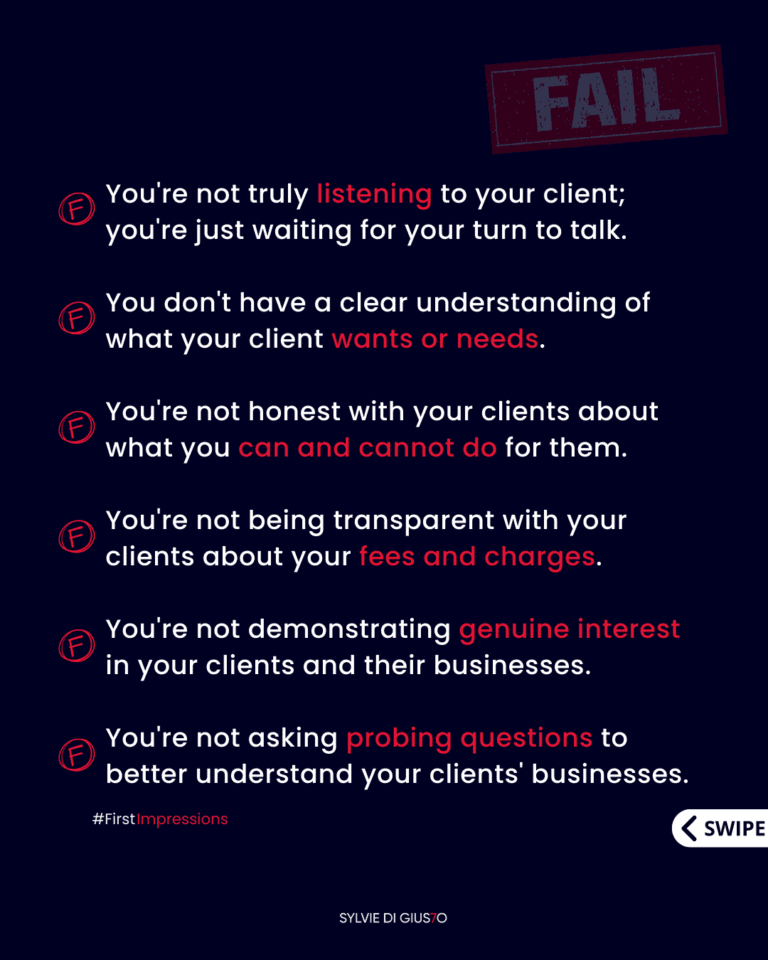
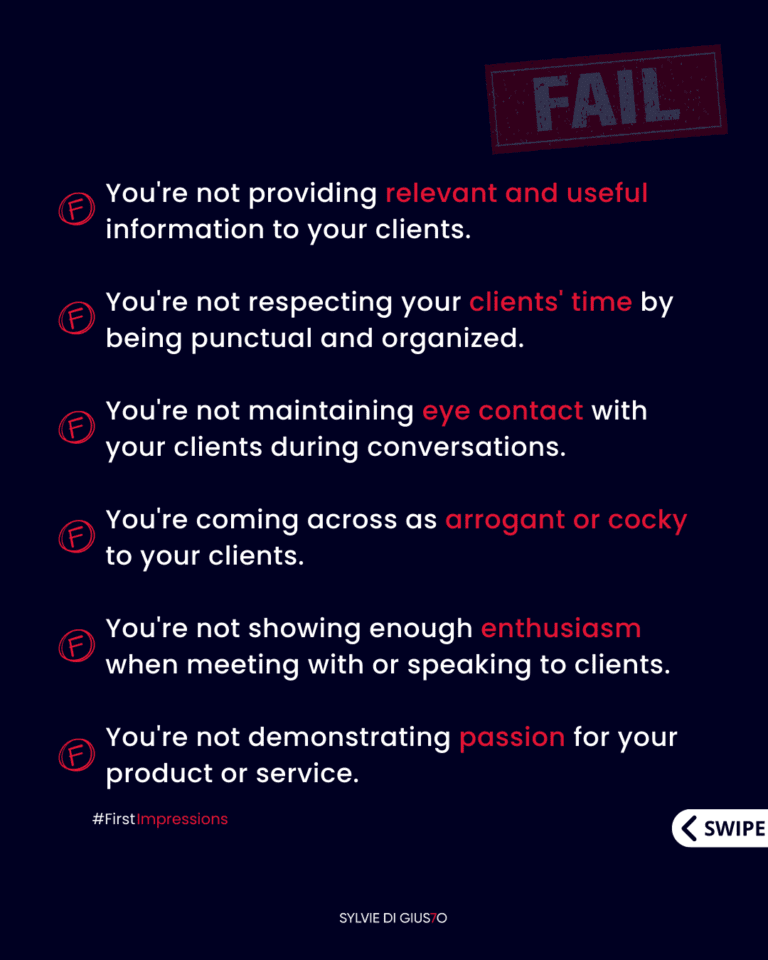
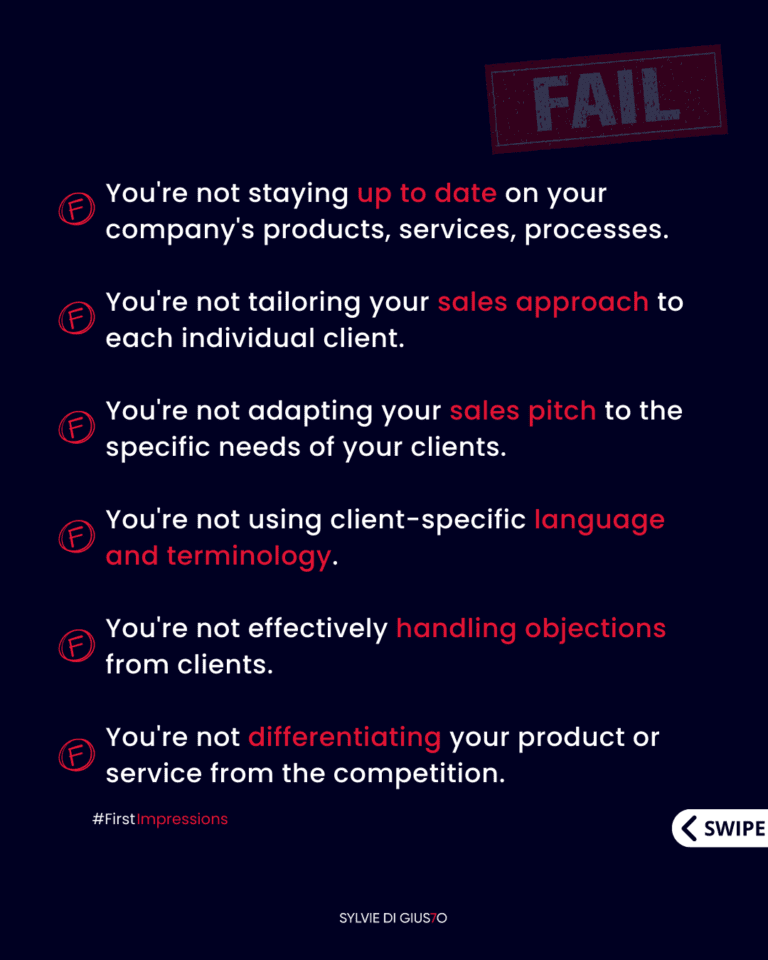
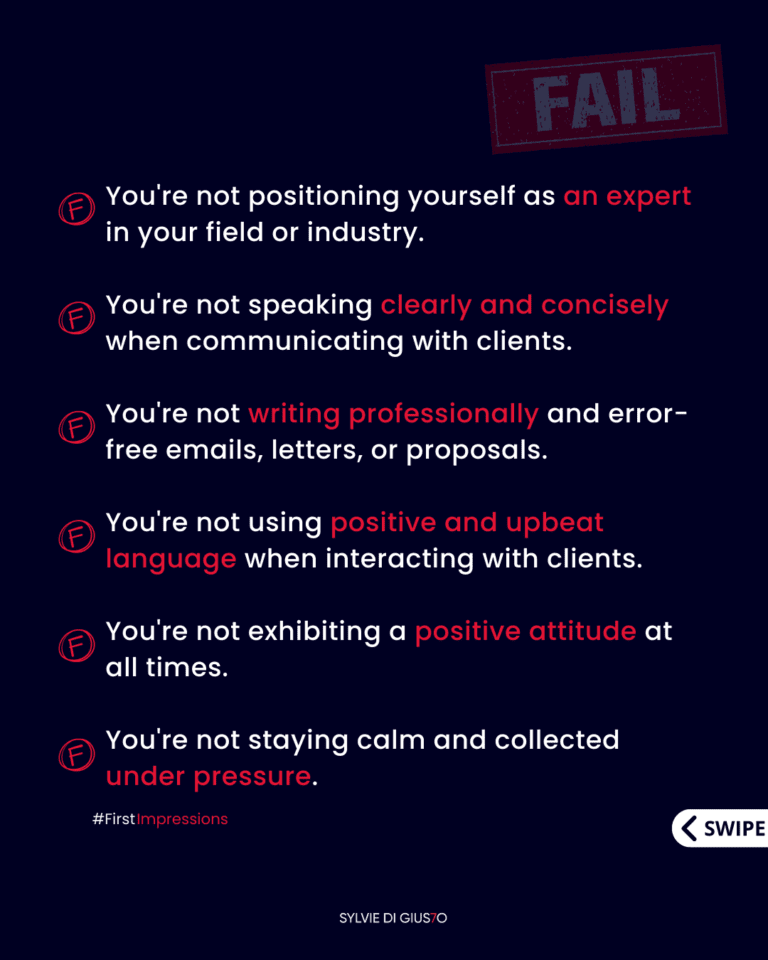
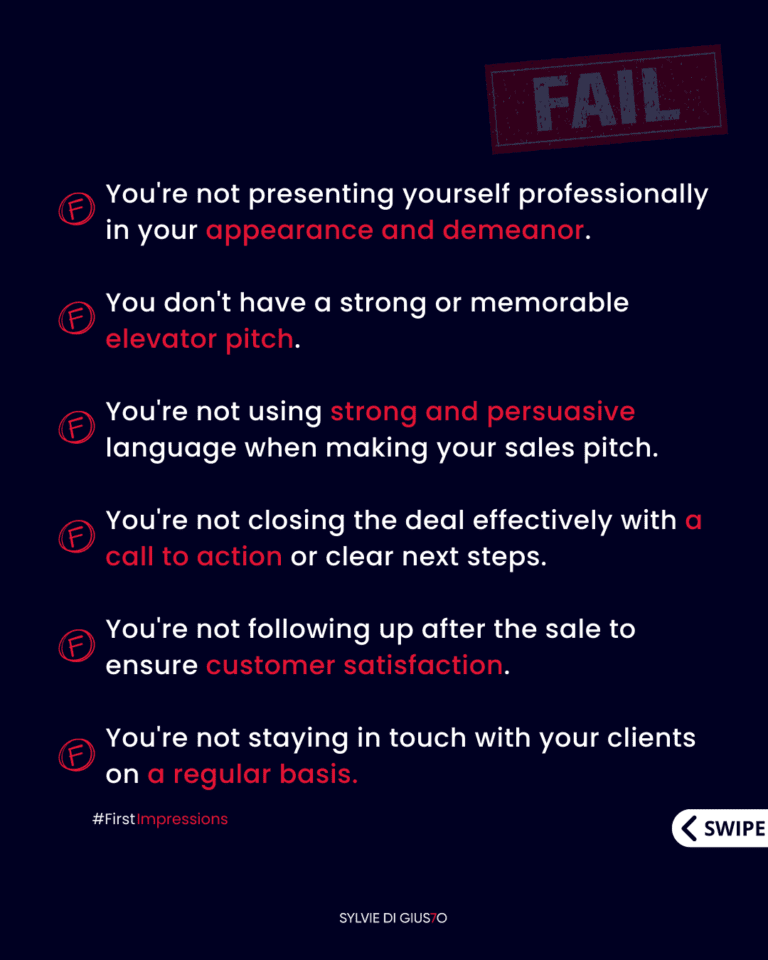
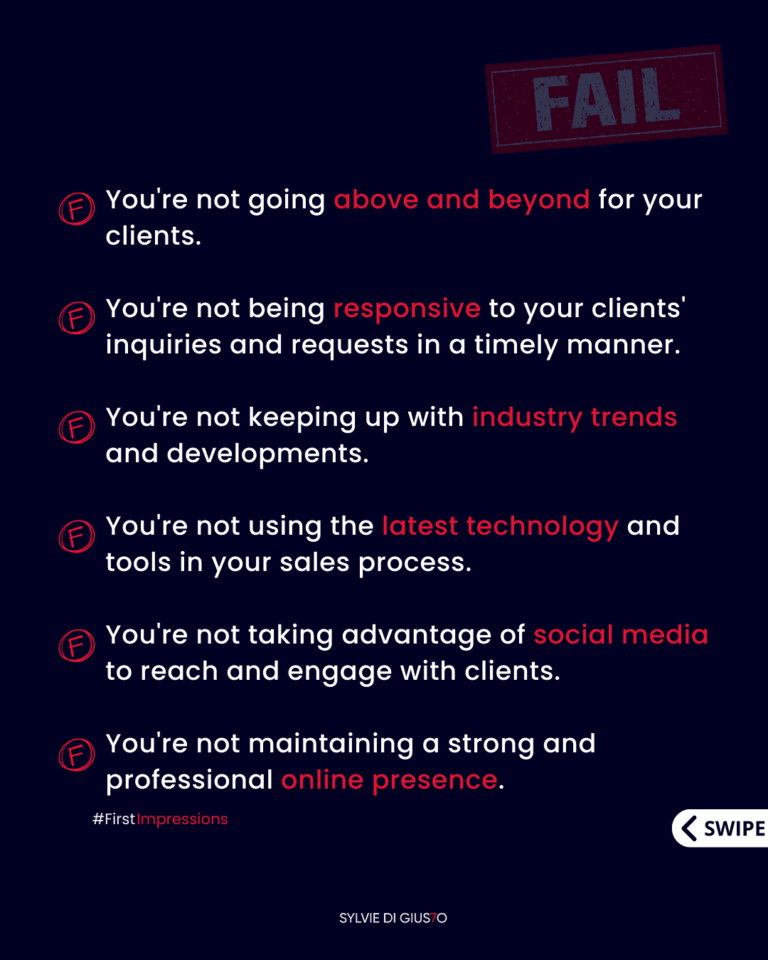
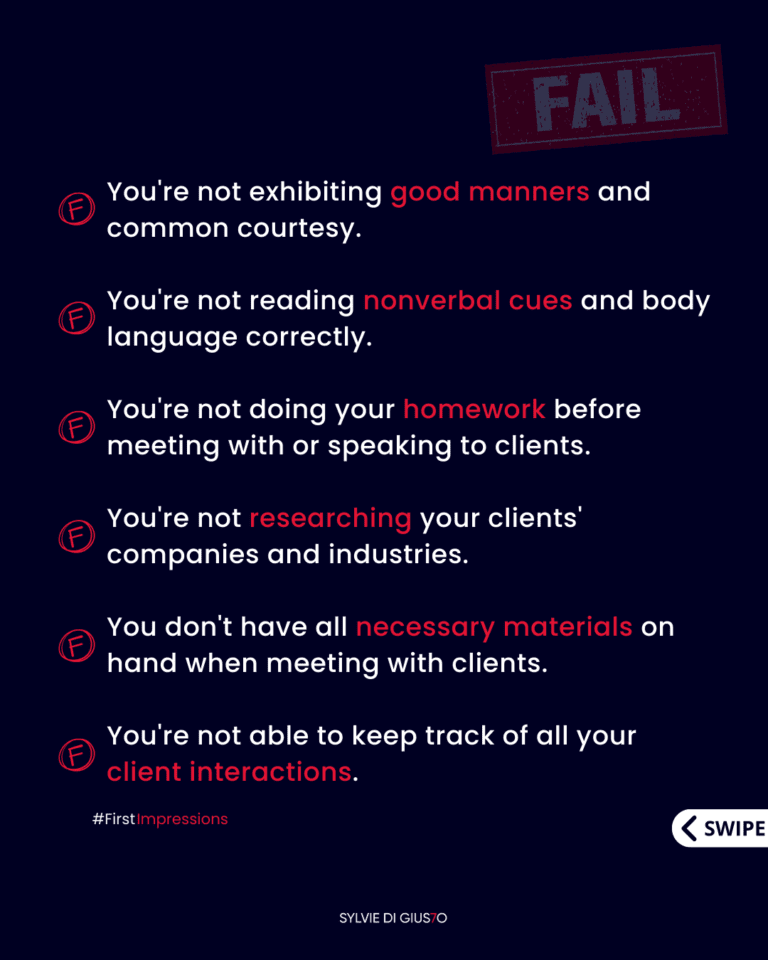
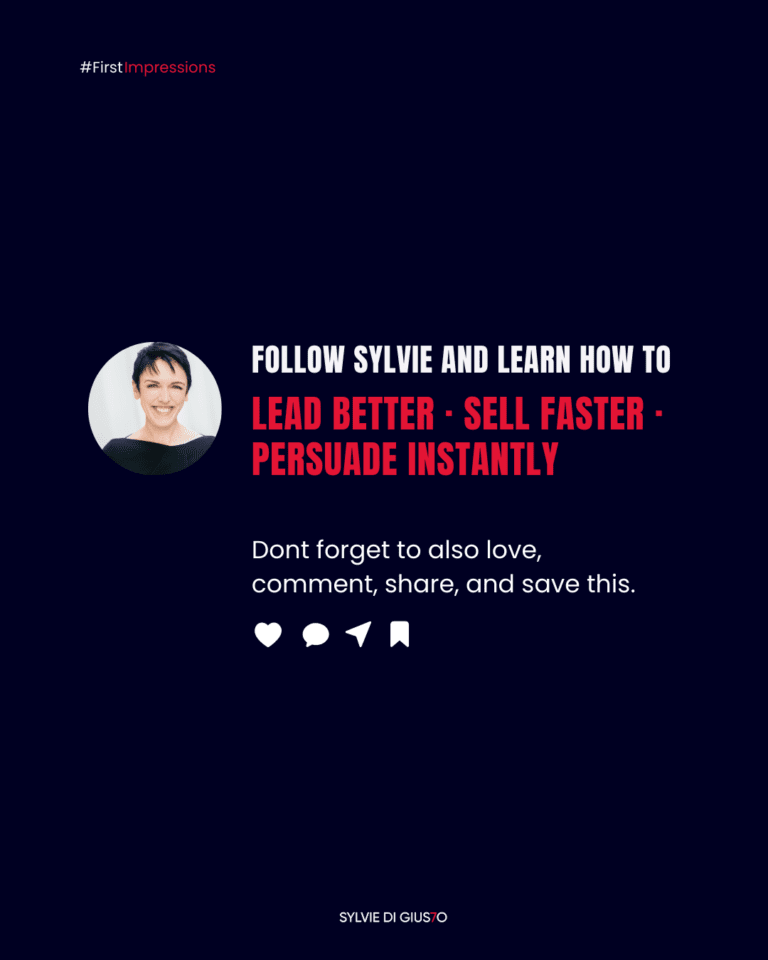
PS: Interested in more content like this? Make sure to follow me on Instagram. It’s where I visualize and publish my thoughts daily. I hope to see you there.




